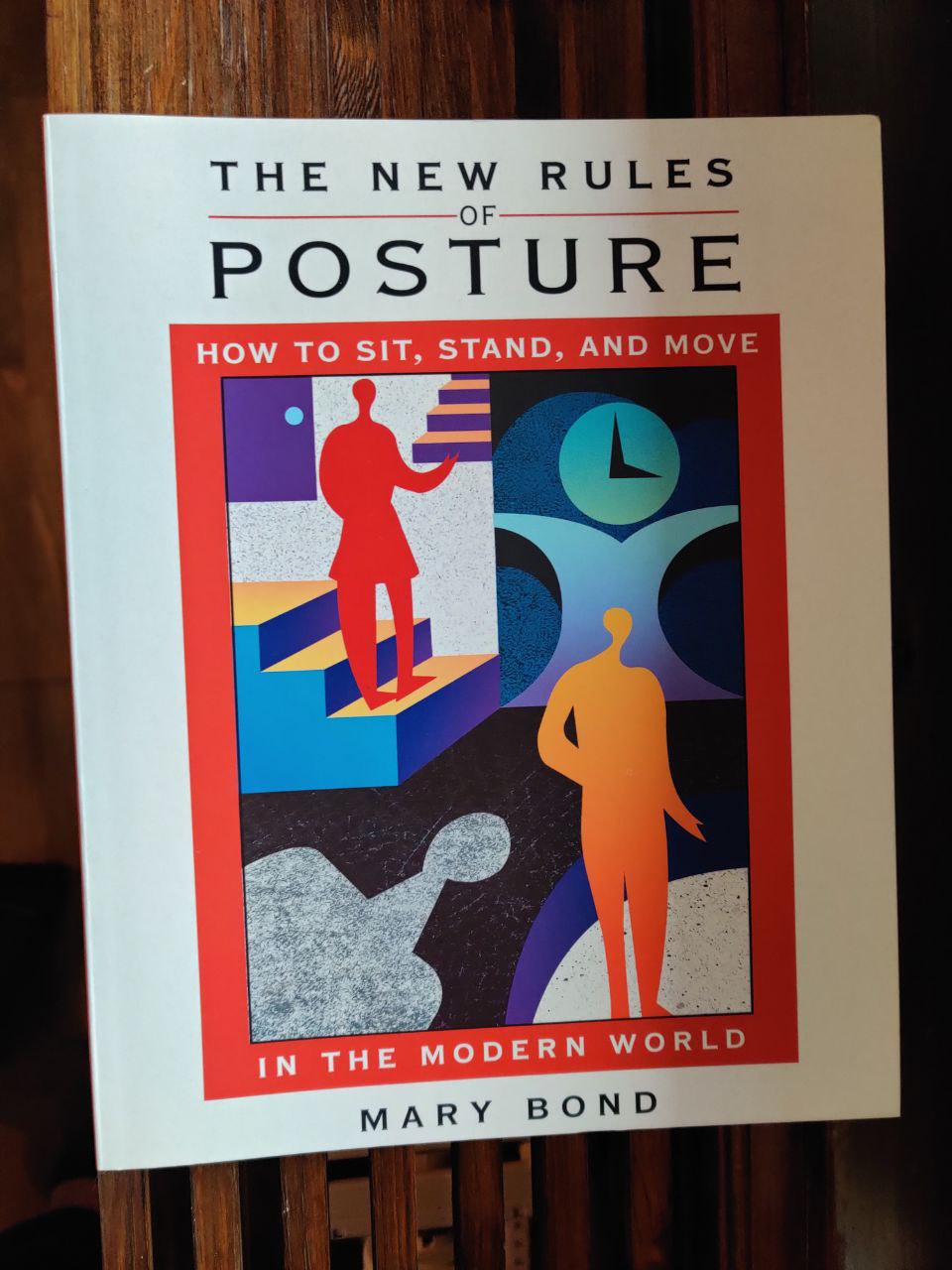The New Rules of Posture: How to Sit, Stand, and Move in the Modern World by Mary Bond

First off I need to get something out of the way: the style of this book was off-putting for me. The imaginary people who are supposed to be the relatable aggregated examples are believable as archetypes but have horrible dialogue and stories. The forays into the spiritual blah-blah and the emotional traumas going a hundred years back rub me the wrong way. The overall tone is sometimes just ugh.
That said, the actual content of the book is highly interesting. I’m speaking from a firm position of zero prior insight into the world of posture, so the “New” bit of the “New Rules” is lost on me, and I can’t compare this book to any other work on the subject. But I do have a back and a neck and all that so I could at least somewhat relate.
And relate I did, no later than on page 54. It had a drawing of a person sitting in front of their computer in a fancy ergonomic chair and this story:
Last month, after getting news of her promotion, Alison splurged on an expensive ergonomic chair. In the past year, she’d spent a fortune on medical tests, physical therapy, and painkilling drugs. In the long run, she figured, the chair would save money.
The pain was a mystery. Alison hadn’t been in any car accidents, had never even broken a bone. She kept in shape with yoga and running. […]
It’s been six weeks now and she’s frustrated. She’s tried every one of the chair’s adjustable features—seat angle, armrest height, lumbar support, and headrest position. Initially each new setting feels comfy. Ahh, that’s it. But within an hour her body is aching, a prisoner of the chair.
To save you the suspense: the chair can have all the settings it wants, but the body is supposed to move and not sit still for hours, so no setting will help. Kiss your Aeron goodbye.
The book has both “explorations” — short mindful exercises to do once or twice to feel some part of the body or a movement you’ve probably haven’t felt before — and “practices” — exercises to repeat on a regular basis. It is a beautiful set of things to do if you want to be frustrated in magnificent brand new ways. No, hear me out, I mean it in a good way. There’s the frustration of not being able to lift 5kg more, there’s the frustration of not being able to swim 100m more or 10 seconds faster, and then there’s the frustration of not being able to move that tiny muscle somewhere deep in your abs that you barely even recognize being there. It does get better though.
And it is the best argument for the book. No matter the style, if you do the suggested exercises and you feel the difference, it’s hard to deny that there’s something to it. One thing which I’m bringing with me to every workout now is this: recall yourself being in a good state, as vividly as possible, before starting to move. The “exploration” about this point went like this. First, recall a stressful moment, something irritating that happened recently. Picture it, stay in it. Then take a few steps. It might be that your breathing got shallower, or your jaw tensed up, or you slouched, or your steps got more rigid. Make note of all that and then recall a pleasurable moment. Not a feeling of happiness or whatever, but an actual moment, maybe one involving a nice smell or a great view. Now walk a few steps and feel the difference.
Tension in the wrong places can spread to even more wrong places through the connecting tissue, and boom, your technique while doing any exercise is all fucked up because you were thinking about your boss saying that irritating thing the other day. So instead, smell the imaginary roses in your head, and squat like a champion with your spine being happy. Or something like that.
The connective tissue gets a lot of attention in the book, I’d say it’s primarily a book about connective tissue and movement. For example:
If you have poor posture, you know that your attempts to “straighten up” don’t last for long. Your muscles are prisoners of their fascial envelopes. Unless fascial planes can freely glide across one another, the function of anything contained within those planes is restricted to some degree, keeping posture and habits of movement fixed.
So all in all, this is a nice book to read if you want to spend some quality time with your body and understand it better. I kinda wish it was longer though — going into more detail for the exercises, giving a few more cues, addressing common mistakes and such. In the final chapter there was a link for “new information, videos, and a forum” which could’ve covered for exactly that, but alas, the link is by now down. I’ve found healyourposture.com but that one just tries to sell you more things by the author and has even more of the tone I didn’t like in the book. Still, a good read.
★★★☆☆
(225 pages, ISBN:9781594771248, Worldcat, Open Library)
There is no comments section, but if you'd like to give feedback or ask questions about this post, please contact me.